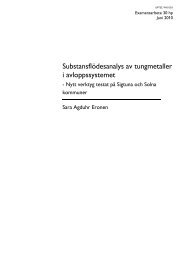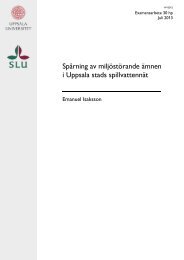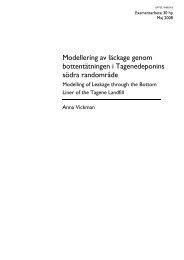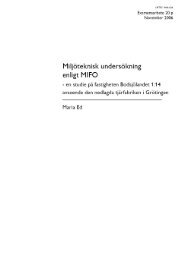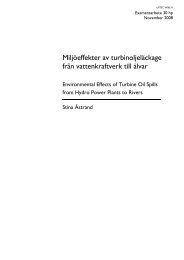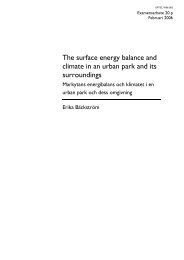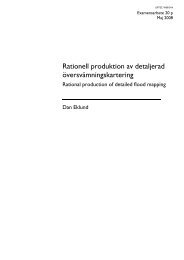Nutrient Transport Modelling in the Daugava River Basin - DiVA Portal
Nutrient Transport Modelling in the Daugava River Basin - DiVA Portal
Nutrient Transport Modelling in the Daugava River Basin - DiVA Portal
Create successful ePaper yourself
Turn your PDF publications into a flip-book with our unique Google optimized e-Paper software.
4.2 IMPACT OF THE CURVE NUMBER ON NUTRIENT SOURCEAPPORTIONMENTThe model was run with different choices of curve numbers accord<strong>in</strong>g to Approach Aand B. The curve numbers are presented <strong>in</strong> table 3.Table 3. The two sets of curve numbers usedLand UseCurve numberApproach A Approach BArtificial surfaces 100 100Cultivated land 80 70Herbaceous land 80 70Lichens and wetlands 80 70Coniferous forest 80 60Mixed forest 80 60Deciduous forest 80 60Water 100 100Figure 9 illustrates <strong>the</strong> impact of <strong>the</strong> curve number on <strong>the</strong> distribution of total nitrogenloads from different land uses. The total nitrogen load <strong>in</strong>cludes surface runoff anderosion from each land use. Water surfaces and cultivated land are <strong>the</strong> ma<strong>in</strong>contributors. With approach A cultivated land makes up most of <strong>the</strong> nutrient loads(71 %) and water surfaces make up 23 %. With approach B <strong>the</strong> relative impact of watersurfaces is enlarged and makes up 54 % of <strong>the</strong> total load while <strong>the</strong> relative impact ofcultivated land is lessened (46 %). The impact of forested land is smaller for approach Bthan for approach A s<strong>in</strong>ce <strong>the</strong> curve number is <strong>the</strong> same for forested land and cultivatedland <strong>in</strong> approach A, but smaller for forested land than for cultivated land <strong>in</strong> approach B.The phosphorus source apportionment is not displayed s<strong>in</strong>ce <strong>the</strong> model fails to predictphosphorus loads.Approach AApproach BCultivated landHerbaceous landLichens and w etlandsConiferous forestMixed forestDeciduous forestWaterCultivated landHerbaceous landLichens and w etlandsConiferous forestMixed forestDeciduous forestWaterFigure 9. The relative contribution to nitrogen loads from each land usewith different methods for choos<strong>in</strong>g <strong>the</strong> curve number.4.3 SENSITIVITY ANALYSISThe result of <strong>the</strong> sensitivity analysis is presented <strong>in</strong> figure 10. The nitrogenconcentration <strong>in</strong> groundwater box 1, C1 g N, is <strong>the</strong> one of <strong>the</strong> analysed parameters whosevalue has <strong>the</strong> greatest impact on <strong>the</strong> nutrient load. A change of this value by 50 % willchange <strong>the</strong> nitrogen load by 27 %. The variable that has <strong>the</strong> least impact on <strong>the</strong> nitrogenload is <strong>the</strong> recession coefficient for box 2, r2. A change of <strong>the</strong> value of this coefficientby 50 % will change <strong>the</strong> nitrogen load by less than 1 %. It should be noted that <strong>the</strong>change <strong>in</strong> nutrient load will be directly proportional to <strong>the</strong> change <strong>in</strong> <strong>the</strong> nitrogen18



